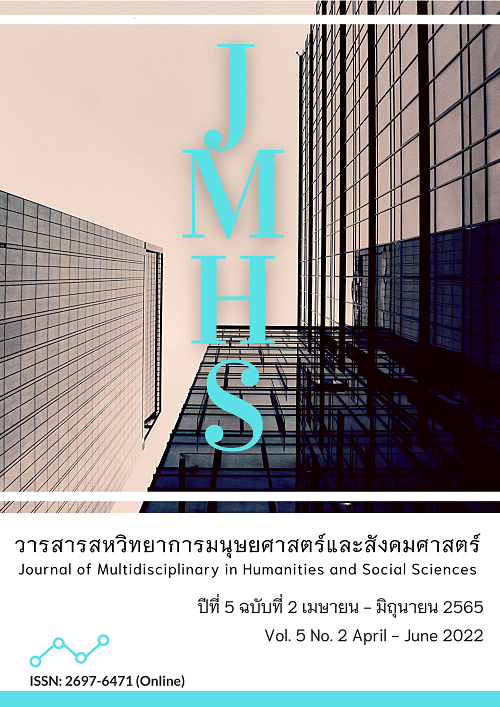The Study of Phra Maha Moggallana Enlightenment in Pacalayamana Sutta
Main Article Content
Abstract
The objectives of this article were 1) to study the attainment of Nibbana in Theravada Buddhist scriptures; and 2) to study the attainment of the enlightenment of Mahamoggallana Thera in Capalāyamāna Sutta by studying data from Theravada Buddhist scriptures and documents related, summarized, analyzed, and compiled in a descriptive style. The results showed that The enlightenment of Mahamoggallana Thera in Capalāyamāna Sutta revealed that the Buddha had shown to the Maha Moggallana eight tactics to relieve from drowsiness, namely: 1) do not meditate on the perception that causes drowsiness; 2) contemplating the teachings that has been learned; 3) One should recite the Dhamma heard and learned; 4) One should stretch the ears on both sides and use his hands to massage it; 5) One should stand up and rub his eyes with water, looking at the four directions and look up at the stars; 6) One should contemplate on the light perception; 7) One should try to walk around; and 8) sleep with overlapping feet sensible along with making a contract, setting waking up perception reminding to wake up. Mahamoggallana Thera had developed Samatha alternating with insight cultivation as taught by the Buddha and attained Arahatship on that day. It was the seventh day since he was ordained as a Bhikkhu. He was regarded as an excellent Bhikkhu with miracle power and a left great disciple of the Buddha.
Article Details

This work is licensed under a Creative Commons Attribution-NonCommercial-NoDerivatives 4.0 International License.
Views and opinions appearing in the Journal it is the responsibility of the author of the article, and does not constitute the view and responsibility of the editorial team.
References
จิรพร ชีวะธรรม และ อุทัย สติมั่น. (2564). วิเคราะห์การพัฒนาชีวิตตามหลักธรรมที่ปรากฏในพระไตรปิฎก. วารสาร มจร บาฬีศึกษาพุทธโฆสปริทรรศน์, 7(1), 96-106.
บรรจบ บรรณรุจิ. (2544). อสีติมหาสาวก. (พิมพ์ครั้งที่ 3). กรุงเทพฯ: โรงพิมพ์มหาจุฬาลงกรณราชวิทยาลัย.
พระครูเกษมธรรมทัต (สุรศักดิ์ เขมรสี). (2548). วิปัสสนาภูมิ. (พิมพ์ครั้งที่ 5). กรุงเทพฯ: บุญศิริการพิมพ์.
พระครูปลัดณัฐพล จนฺทิโก. (2561). การปรับจริตเพื่อพัฒนาชีวิต: กระบวนการ และแนวปฏิบัติ. วารสารปณิธาน, 14(1), 55-84.
พระครูปลัดสัมพิพัฒนธรรมาจารย์ (นิรันดร์ ศิริรัตน์), พระเทพสุวรรณเมธี (สุชาติ หวลจิตต์), พระมหาวิโรจน์ คุตฺตวีโร และ สังวาลย์ เสริมแก้ว. (2564). แนวคิดคำสอนเรื่องกามตามหลักพระพุทธศาสนาเถรวาท. วารสารศิลปการจัดการ, 5(3), 798-811.
พระธรรมธีรราชมหามุนี (โชดก ญาณสิทฺธิ). (2549). โพธิปักขิยธรรม 37 ประการ. (พิมพ์ครั้งที่ 6). นนทบุรี: สัมปชัญญะ.
พระพรหมคุณาภรณ์ (ป.อ. ปยุตฺโต). (2556). พจนานุกรมพุทธศาสน์ ฉบับประมวลศัพท์. (พิมพ์ครั้งที่ 21). กรุงเทพฯ: ผลิธัมม์.
พระพุทธโฆสเถระ. (2554). คัมภีร์วิสุทธิมรรค. (สมเด็จพระพุฒาจารย์ (อาจ อาสภมหาเถร), แปล). (พิมพ์ครั้งที่ 10). กรุงเทพฯ: ธนาเพรส.
พระสมชาย บัวแก้ว, พระมหาบุญศรี วงค์แก้ว และ สุเชาวน์ พลอยชุม. (2564). อภิสมาจาร: กระบวนการพัฒนาบุคลิกภาพตามแนวพระพุทธศาสนา. วารสารศิลปการจัดการ, 5(3), 895-907.
มหาจุฬาลงกรณราชวิทยาลัย. (2552). อรรถกถาภาษาไทย ฉบับมหาจุฬาลงกรณราชวิทยาลัย. กรุงเทพฯ: โรงพิมพ์มหาจุฬาลงกรณราชวิทยาลัย.
มหาวิทยาลัยมหาจุฬาลงกรณราชวิทยาลัย. (2539). พระไตรปิฎกภาษาไทย ฉบับมหาวิทยาลัยมหาจุฬาลงกรณราชวิทยาลัย. กรุงเทพฯ: โรงพิมพ์มหาจุฬาลงกรณราชวิทยาลัย.
อุไรพร ประชาบุตร และ วิไลศักดิ์ กิ่งคำ. (2564). ศึกษาความสัมพันธ์ระหว่างอานาปานสติกับไตรลักษณ์ ในคัมภีร์พระพุทธศาสนาเถรวาท. วารสาร มจร บาฬีศึกษาพุทธโฆสปริทรรศน์, 7(2), 1-12.
Chanthathong, S. (2021). The Significance of the Right View (Sammaditthi) in Theravada Buddhism. Journal of International Buddhist Studies, 12(1), 61-70.
Damnoen, P. S., Siri, P., Supattho, P. S., & Kaewwilai, K. (2021). The Development of Student Characteristics in According to the Nawaluk Framework of the Buddhist integration of Buddhapanya Sri Thawarawadee Buddhist College. Asia Pacific Journal of Religions and Cultures, 5(2), 126–135.
Suwan, P. R. (2021). The Roles of Buddhism for Supporting Thai Community in Thailand. Journal of International Buddhist Studies College, 6(1), 72–79.
Tan, C. C., & Damnoen, P. S. (2020). Buddhist Noble Eightfold Path Approach in the Study of Consumer and Organizational Behaviors. Journal of MCU Peace Studies, 8(1), 1–20.


